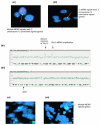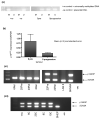High Frequency of p53/MDM2/p14ARF Pathway Abnormalities in Relapsed Neuroblastoma
- PMID: 20145180
- PMCID: PMC2842933
- DOI: 10.1158/1078-0432.CCR-09-1865
High Frequency of p53/MDM2/p14ARF Pathway Abnormalities in Relapsed Neuroblastoma
Abstract
Purpose: Most neuroblastomas initially respond to therapy but many relapse with chemoresistant disease. p53 mutations are rare in diagnostic neuroblastomas, but we have previously reported inactivation of the p53/MDM2/p14(ARF) pathway in 9 of 17 (53%) neuroblastoma cell lines established at relapse.
Hypothesis: Inactivation of the p53/MDM2/p14(ARF) pathway develops during treatment and contributes to neuroblastoma relapse.
Methods: Eighty-four neuroblastomas were studied from 41 patients with relapsed neuroblastoma including 38 paired neuroblastomas at different stages of therapy. p53 mutations were detected by automated sequencing, p14(ARF) methylation and deletion by methylation-specific PCR and duplex PCR, respectively, and MDM2 amplification by fluorescent in situ hybridization.
Results: Abnormalities in the p53 pathway were identified in 20 of 41 (49%) cases. Downstream defects due to inactivating missense p53 mutations were identified in 6 of 41 (15%) cases, 5 following chemotherapy and/or at relapse and 1 at diagnosis, postchemotherapy, and relapse. The presence of a p53 mutation was independently prognostic for overall survival (hazard ratio, 3.4; 95% confidence interval, 1.2-9.9; P = 0.02). Upstream defects were present in 35% of cases: MDM2 amplification in 3 cases, all at diagnosis and relapse and p14(ARF) inactivation in 12 of 41 (29%) cases: 3 had p14(ARF) methylation, 2 after chemotherapy, and 9 had homozygous deletions, 8 at diagnosis and relapse.
Conclusions: These results show that a high proportion of neuroblastomas which relapse have an abnormality in the p53 pathway. The majority have upstream defects suggesting that agents which reactivate wild-type p53 would be beneficial, in contrast to those with downstream defects in which p53-independent therapies are indicated.
Figures




References
-
- Keshelava N, Zuo JJ, Chen P, et al. Loss of p53 function confers high-level multidrug resistance in neuroblastoma cell lines. Cancer Res. 2001;61:6185–93. - PubMed
-
- Lane DP. Cancer. p53, guardian of the genome. Nature. 1992;358:15–6. - PubMed
-
- Michalak E, Villunger A, Erlacher M, Strasser A. Death squads enlisted by the tumour suppressor p53. Biochem Biophys Res Commun. 2005;331:786–98. - PubMed
-
- Stone S, Jiang P, Dayananth P, et al. Complex structure and regulation of the P16 (MTS1) locus. Cancer Res. 1995;55:2988–94. - PubMed
MeSH terms
Substances
Grants and funding
LinkOut - more resources
Full Text Sources
Medical
Molecular Biology Databases
Research Materials
Miscellaneous

